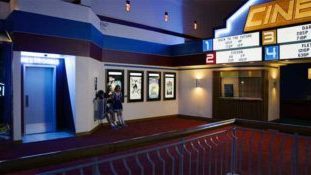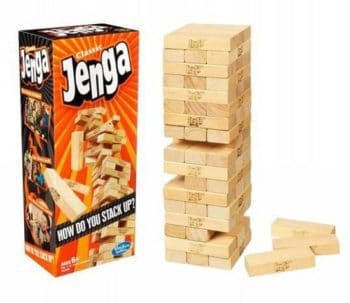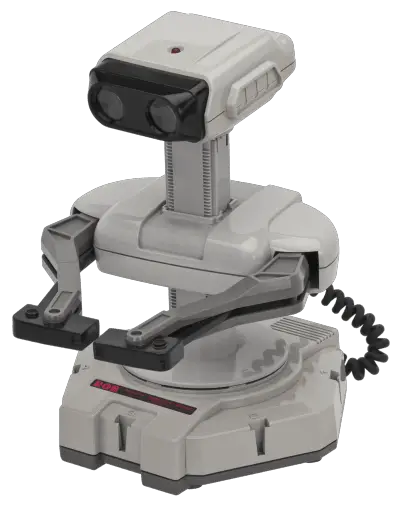
There have been a bunch of accessories for Nintendo over the years but one was absolutely critical in their success.
The Robotic Operating Buddy, or R.O.B. was a robotic assistant for the Nintendo Entertainment System that could play games with you. It was seen as slow and challenging to use, wouldn’t last long, but was crucial in how Nintendo would market their new video game system.
The 80s were a big decade for robots, you had Transformers, Johnny-5 from Short Circuit and all those cute little droid things from “Batteries Not Included”. And you also had the Robotic Operating Buddy or R.O.B put forth by Nintendo.
Was R.O.B something that was over promised and under delivered as a video game accessory? Maybe, but that might not have been the point as the R.O.B might have been only intended to help change the direction and perception of video games, get them back on the shelves, and ultimately relaunch an industry.
This is the story of how R.O.B might have saved the video game industry
Coming Out Of The Dark Era
It seems weird to think but there was a time when video games were not in demand at all. Not only that, manufacturers wanted nothing to do with them. It’s not that they went away but the great video game crash of 1983 shook the industry to its knees and bankrupted Atari.
This story needs a bit of a history lesson as Atari obviously dominated through the 70s and into the early 80s. The problem was Atari didn’t have a control on the games that were released for the Atari 2600 video game system. Whereas Nintendo had their “seal of quality” which ensured that anything released for the NES had to meet their standards, any yahoo could put out an Atari game.
This led to A LOT of crap games that flooded the market. Consumer confidence was starting to drop in Atari – and video games in general – that the market was starting to drop. Though it’s not the direct cause of the video game crash, the E.T. Atari video game set in motion the events that would lead to it and bring Atari to their knees. You have to check out my article on the E.T. Atari game to see how this whole ordeal went down.
Basically, by 1984/85 Atari had been broken up and sold off. Video games were seen as the kiss of death and companies like Mattel and Hasbro lost millions in investments in video game technology. Many companies would go back to more traditional toys that were not a risk, and it’s why you would see toys like the Pound Puppies be introduced.
The Nintendo Entertainment System To The Rescue
You need to check out my article all about the evolution of the Nintendo company and the release of the NES but the quick run down is this: The NES started out as the Famicom in Japan and they wanted to release it in the states but had great trepidation in doing so. They were going to partner with Atari for the release but an incident at the 1985 Consumer Electronics Show put the kibosh on the whole deal (seriously, check out my NES article) and Nintendo decided to go it alone.
There were a few big things they banked on to help ensure that the NES was a hit; The first was the creation of a new character called Mario that would never have happened if it wasn’t for Popeye (check that article out here) the other was the creation of a kind of old technology called the light gun which you would know as the Nintendo Zapper along with the classic game Duck Hunt – here’s my very interesting article on the development of both the zapper and Duck Hunt.
The next big thing had to do with word usage and this – along with R.O.B – is what may be ultimately responsible for the success of Nintendo and the rejuvenation of the video game industry.
This Is Not Your Older Brothers Video Game System
Whatever Atari had stood for, Nintendo wanted to be the opposite – and this included the verbiage associated with Nintendo. To distance themselves from “computer video games” Nintendo would adopt a new language when it came to their product.
- Atari had a video game console – Nintendo had the “control deck”
- Atari had video game cartridges – Nintendo had “game paks”
- Atari was a video game system – Nintendo was an “entertainment system”
- Atari used old style arcade joysticks – Nintendo used modern “control pads”
- Atari had elaborate artwork on the cartridges that looked nothing like the game – Nintendo would use 8-bit graphic images on the game paks resembling the real game
- Atari had a wood cabinet design that looked like your old TV – Nintendo had a futuristic “space grey” sleek and modern design to it.
One other big thing that was kind of a last second change was how you would use the actual game paks on the NES. Atari used the upright insertion slot for their cartridges and this was similar to what the Famicom used. To further distance itself from looking like a video game system Nintendo developed a whole new design – the game paks would be inserted into the front the same way you would put a VHS tape on the newly popular VCR.
This would give the Nintendo Entertainment System a familiarity and further distance itself from Atari. It was almost like the Nintendo was an appliance more than a video game system. And this seems to be the direction Nintendo wanted to go. Above all, they wanted to push the idea that the NES was a TOY and not specifically a video game system.
And the Robotic Operating Buddy might have been the final way to cement this new approach.
What was R.O.B?
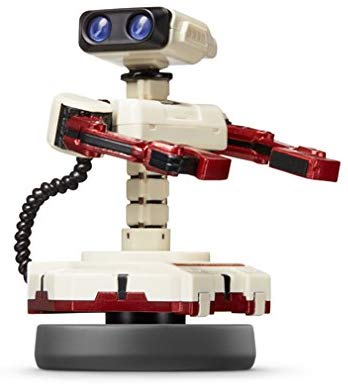
R.O.B. started out as the Family Computer Robot in Japan when it was connected to the NES predecessor, the Famicom (family computer). The Family Computer Robot was released quite late in the existence of the Famicom coming out in 1985 – two years after the Famicom did.
The Family Computer Robot worked in a similar way to the Light Gun that had been released by Nintendo in Japan. It would receive commands via optical flashes on the screen of a CRT television. CRT means cathode ray tube, and it’s why the R.O.B., or the Zapper gun, won’t work on modern HD televisions.
Once the screen lights up, it was ready to receive one of six different commands and this would be dependent on what game it was using. R.O.B. would only end up being able to be used with two games which we’ll get to in a bit Those precise flashes hit a sensor in the robot’s head which was pretty advanced tech for a home toy at the time. The other interesting thing was that it wasn’t hooked up to the NES in any way
It was 24 inches high and had a head movement range of 45 degree horizontally centered tilt. It contained arms that had a movement range of 240 degrees to the left and the right with five different stopping points. It had five accessory slots around the base, numbered clockwise, and special notches on the hands meaning it could incorporate different accessories. It was powered by four AA batteries and even included a set of “shades” which was a tinted filter in order to accommodate brighter TV screens.
Bringing R.O.B. To North America
So as I’ve mentioned there was a lot of trepidation in releasing a new video game system to North America and Nintendo wanted to have all their bases covered. The sole marketing staff of Nintendo of America was Gail Tilden, and she had the monumental job of promoting the NES as an advanced toy, as opposed to just another video game system. Gail Tilden also founded “Nintendo Power” which is amazingly Epic.
Tilden decided to put all their eggs in one basket and make the NES deluxe set the showcase combination going into the 1985 test launch. The deluxe set would include the control deck, two controllers, the Zapper gun, and Duck Hunt (which was also seen as a big risk) and the game Gyromite.
To further indicate that this was high-technology – that no one had seen in a video game system before – they decided very late to include the Family Computer Robot from Japan, but redesign it to have the new NES color scheme. They also wanted to change the name and first considered calling it “OTTO” (which would be a play on the word/ auto) but then came up with calling it the Robotic Operating Buddy, or R.O.B.
The main thing to point out here is that the focus was so important on the NES being an advanced technological toy that the featured premium set – the deluxe set – didn’t even include the Super Mario Brothers game. That’s how critical it was for them to make a splash and R.O.B. was seen as being the cornerstone of all this.
The Two Games That Came With R.O.B.
So I mentioned Gyromite as one of the games that was designed for R.O.B. and the idea was that you had this robotic assistant helping you to play the game. In the case of Gyromite, there were a few accessories needed for R.O.B. to be able to play it.
Gyromite came in a retail package that included two claws for R.O.B.’s hands, two heavy spinning tops (or gyros) and two red and blue trays that the gyros would rest on. This combination would cause buttons to be pressed on the second controller and also had a spinning motor to spin the gyros.
Before playing you would have to put R.O.B. in standby mode to make sure he was pointed at the TV and active. Before playing Gyromite you would have to run a test – which was one of the options on the home screen – and this would send a signal from the TV to R.O.B. to make sure he was focused on the TV screen.
I guess R.O.B. had some attention deficit disorder issues…
Gyromite is a puzzle type game involving platforms where the main character (who I think was a scientist?) has to collect dynamite before the time runs out. Blocking his way are red and blue pillars and this is where it gets confusing AF.
One way to play the game is where you can push the direction to move R.O.B. and use the A and B buttons to open and close his arms. If R.O.B. places a gyro on the red or blue button, it pushes the A or B button on the second controller. This moves the pillar of the corresponding color in the game and allows the scientist to pass through – It’s like R.O.B. is an electronic gatekeeper. So it’s not like R.O.B. is automatically doing everything himself, you are still controlling him to make the movements left and right and to press the right controller buttons.
Stack Up
This is the second game released for R.O.B. and came with five different trays, five different colored blocks, and two claws for R.O.B. so that he could grab the blocks. There was a direct game mode and you would try to make your block stack match up with the one that was on the screen. You would do this by moving “Professor Hector” to the button that would correspond with the same movement.
There was a “Memory” version of the game too and in this one, you would have to create a list of commands to create a block stack up that was displayed on the screen. R.O.B. would then follow this list of commands to go through the movements.
There was also a Bingo type game where you would have to create a stack of blocks that was shown on screen while having to deal with two different enemies – one would make you lose a life and the other would make R.O.B. do some crazy actions.
If this seems overly complicated and drawn out – it was. To call these games fun would be an understatement. The idea is amazing but the execution with the (at the time) lackluster technology left a lot to be desired.
Some neighbors down the street were the first people I knew to have R.O.B. and it if you ever got to play with one you know how it was an agonizingly slow process to play these games, and honestly, not fun at all. It was as novelty as novelty got but this might have been the intention all along – as we’ll soon see.
Getting Nintendo & R.O.B. On The Market
So I mentioned that the focus of the release of Nintendo in North America was with the deluxe package that included R.O.B. Test markets such as New York were first used as it was a big enough city, with a huge sample size, so they could get a pretty good idea of demographics and feedback.
The early promotional material and commercials had R.O.B. front and center. If you look back on any of the old marketing, you will never once see the word “video game” used, and the focus was on entertainment. This carried over to the in-store display units. In each store, they had huge R.O.B. centered promotional displays that included a glass display showcasing the whole deluxe set.
Remember, stores still saw video games as the black sheep of the toy industry and promoting anything like this was still seen as a huge gamble. Nintendo came up with their Godfather offer and they gave the stores an offer they couldn’t refuse. Nintendo would stock the stores, and provide the displays, for 90 days, and the stores wouldn’t have to spend a cent. After 90 days they could pay Nintendo for what sold and anything that didn’t they could give back.
For the stores they had nothing to lose and for Nintendo, as big a gamble as it seemed, they really had no choice if this thing was going to hit. They started with 500 stores in the New York area on October 9, 1985 and on October 18th, with R.O.B. front and center, it was released throughout North America.
I can’t stress enough how crazy it was that Nintendo started their introduction into North America without featuring Super Mario Brothers at first.
The Initial Impact Of R.O.B. & Nintendo
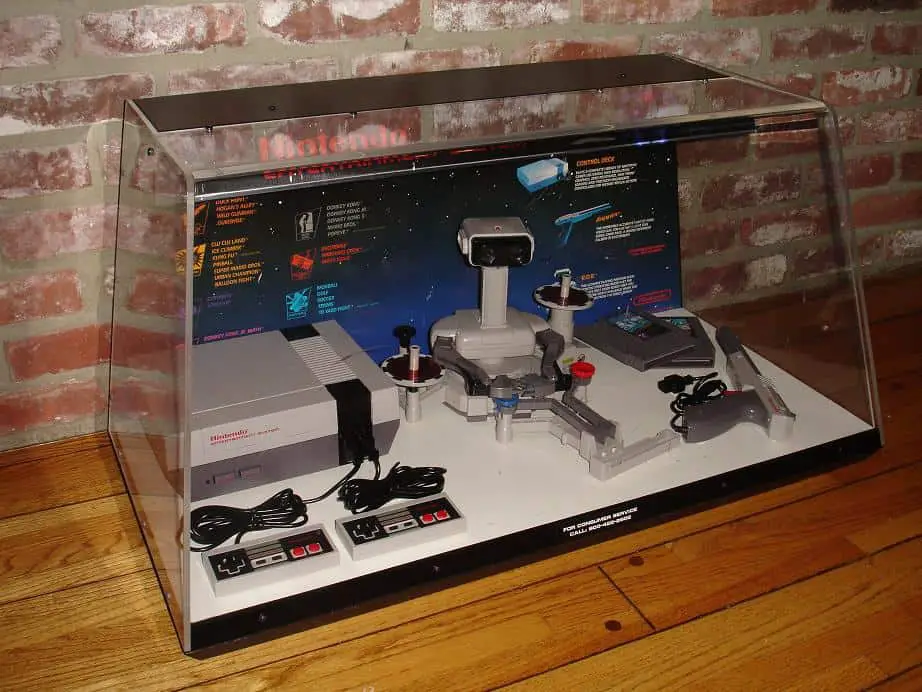
In all the stores that had promotional displays the store owners were requested to showcase R.O.B. and actually had a script to follow to talk about how he (wait, is it a he?) worked and all the functionality. The early reviews from game critics were less than glowing and the focus was on how complicated this “robot assistant” was.
It was hard to ignore that there were only two games that you could use with R.O.B. (out of the 17 first released) and it seemed like Nintendo was selling R.O.B.’s and the NES just happened to go with it. They had plans for four more R.O.B. based games but you’ll see why these never came out – or you can already start to see why they would never come out.
But critics be damned because we all know how amazing the original NES was. Nintendo knew how great their product was and they just had to get it into our dirty little hands. R.O.B. is what helped do this. The other packages were now being released and everyone was realizing how UNBELIEVABLE the game with the little Italian plumber was. The Duck killing game with the cool Zapper gun was also pretty amazing. The graphics, music, and gameplay of this new system was miles ahead of what we had before.
Word of mouth spread and kids like me were screaming to get an NES. By the end of 1985, Nintendo passed its goal of selling 50,000 units. This was starting to grow and the Nintendo effect was catching on. In polls of adults and kids, 89% of adults said they would recommend it to friends and neighbors and 83% of kids said the same thing.
This seems weird to me that kids would have a bit less recommendation than adults but this might be on par with what Nintendo expected. In Japan, it wasn’t kids that were the real big market for the Famicom, it was more young adults that were playing it. I imagine they thought this might be similar in North America but the kid market grabbed hold of this thing and the direction for everything Nintendo did would be focussed on them.
So the big thing from this poll was why parents bought an NES. 26% said because their kids had basically bugged the crap out of them for it, and what was reported as the #1 reason why kids wanted it?
R.O.B.
Why The NES Was So Successful
By the end of 1986 Nintendo had sold 4 million NES consoles and had pretty much rejuvenated the entire video game industry. The Mario era had now taken hold and they would ride this out for decades – and actually still are to this day.
Video games were now back in the mainstream, not a fad anymore, and growing at a rapid rate. By 1988 R.O.B. – even though he was seen as an unnecessary feature – was pretty much “retired”. But his job was done. He had helped avoid a barrier to entry into the relaunch of video games and was basically a pawn to get people’s attention – specifically, kids.
R.O.B. has been called a “Trojan Horse” in that people took him at face value thinking this was the focal point of this new system. In reality, R.O.B. was just a way to get into peoples homes so they could find out how amazing this new video game system was – sorry, “entertainment system”.
I still wonder if this was 100% their game plan as I don’t think any company could have had such a full proof plan (check out my article on the inadvertent success of New Coke to see this in action). R.O.B. wasn’t great, and they had to have known this, so they couldn’t have bet the house on this accessory. There’s no doubt they knew how great their product was but at the very least R.O.B. made this new system look like a toy and that was one of their clear objectives.
Final Thoughts On R.O.B.
You could look at R.O.B. from a drug dealer aspect (bear with me) as it was used to give you a taste and then get you hooked on the real thing. I think if Super Mario Bros. wasn’t as good as it was that could have skewed their success but it was and there was no stopping Nintendo.
I’m not sure if you ever got to play with R.O.B. but like I had mentioned, it wasn’t amazing – but it was still cool as hell. You had a robot in your house that played video games with you. I remember playing with it for a bit at my neighbours but then becoming disinterested in the slow, methodical play and switching back to regular games.
It also suffered from having to use quickly dying batteries and having lots of separate parts and accessories that would no doubt get lost, or eaten by your dog.
But either way, the story of R.O.B. is an amazing one as you see how critical it was to the launch of the NES and how crucial it was in their eventual success.

